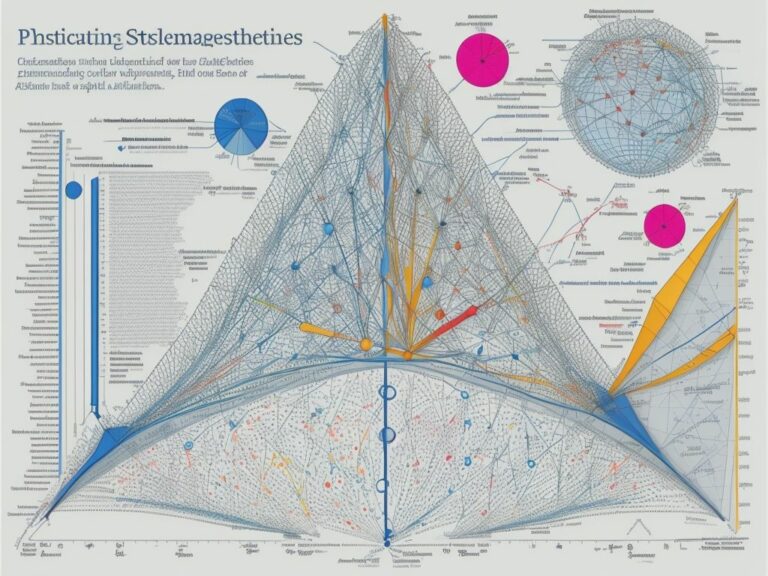Deciphering Bayesian Statistics
Bayesian statistics take us into the world of probability and inference. This strong framework allows us to make sense of uncertain info and draw meaningful conclusions. We combine prior knowledge with new data, giving us a flexible way to tackle complex problems in many areas.
Here, we investigate the basics of Bayesian stats and how they vary from classical frequentist approaches. Instead of depending only on observed data, Bayesian methods use prior beliefs and give probabilities to different hypotheses. This use of prior info ensures our analysis isn’t just based on data, but also considers earlier knowledge.
Bayesian stats have a unique feature: updating our beliefs as new evidence appears. This repetitive process gives us a dynamic understanding of what’s going on, altering our conclusions as we get more information. Additionally, Bayesian stats involve computing posterior probabilities using Bayes’ theorem, which gives us a formal way to mix prior beliefs with observed data.
Pro Tip: It’s essential to carefully consider priors when working with Bayesian stats. If the priors are too informative or biased, they can greatly affect the posterior probabilities. So, it’s important to pick priors that faithfully reflect our prior knowledge while letting the data have a considerable impact on our final results.
What are Bayesian Statistics?
Bayesian statistics, a branch of statistical analysis, utilizes probabilistic reasoning and Bayes’ theorem to update our beliefs about events or hypotheses based on new evidence. It employs a flexible framework that incorporates prior knowledge and observed data to make inferences and predictions. By quantifying uncertainty and accounting for various sources of information, Bayesian statistics provides a comprehensive approach to decision-making and hypothesis testing.
Understanding Bayesian statistics can empower researchers and practitioners to make more informed and reliable conclusions in a wide range of fields such as medicine, finance, and engineering.
Moreover, Bayesian statistics offers advantages over traditional frequentist methods by offering a coherent framework for incorporating prior knowledge, allowing for the use of smaller sample sizes, and providing a straightforward measure of uncertainty through credible intervals. It also allows for the updating of beliefs as new data become available, providing a dynamic and iterative approach to analysis. By considering both prior beliefs and observed data, Bayesian statistics provides a more nuanced understanding of the implications of the data and helps avoid biased or misleading conclusions.
To fully appreciate the power of Bayesian statistics, it is essential to grasp key concepts such as prior and posterior distributions, likelihood functions, and Markov chain Monte Carlo methods. These tools enable researchers to quantify uncertainty, compare different hypotheses, and obtain reliable estimates of parameters of interest. Bayesian statistics requires careful consideration of prior assumptions and the selection of appropriate models, but it offers a rigorous and coherent framework for statistical inference.
Incorporating Bayesian statistics into your research or decision-making process can lead to more robust and informative results. By embracing uncertainty and actively updating beliefs based on new evidence, Bayesian statistics helps to minimize the risk of making overly confident or incorrect conclusions. Don’t miss out on the benefits that Bayesian statistics can offer – delve into this powerful approach and enhance your analytical toolkit today.
Trying to understand Bayesian statistics is like trying to decipher the secret scroll of a mathematician who had too much time on their hands and not enough friends.
Explanation of the Bayesian approach
Bayesian statistics is a way of handling uncertainty in data analysis. It takes prior information, combines it with new facts, and produces a more precise outcome. This technique is employed in many different fields like machine learning, data science, and decision-making.
Bayesian stats begin with assumptions about the parameters being evaluated. These priors are combined with the data using Bayes’ theorem to get the posterior distribution. This shows our updated views of the parameters after taking in the data.
An interesting thing about Bayesian stats is its capacity to quantify uncertainty. Instead of single results, Bayesian methods give a probability distribution to each parameter. This lets us see the range of possible values.
For instance, imagine a doctor trying to diagnose a patient with an uncommon disease. The doctor has some prior knowledge of the illness’s occurrence in the population and the accuracy of tests. But the tests come back with inconsistent results. With Bayesian stats, the doctor can change their thoughts based on the test outcomes and come to a better diagnosis.
Comparison with frequentist statistics
Comparing Bayesian and frequentist statistics reveals some major differences. Let’s explore them!
| Bayesian Statistics | Frequentist Statistics | |
|---|---|---|
| Approach | Accounts for prior knowledge and incorporates new data | Rely solely on observed data & ignore prior |
| Probability | Probability measures uncertainty about a parameter or event | Probability is long-run frequency of an event |
| Parameter Estimation | Uses posterior distribution to estimate parameters | Maximum likelihood estimation or confidence intervals used |
| Sample Size | Smaller sample size due to prior info | Larger sample size for accurate estimation |
Bayesian offers a flexible & intuitive approach when dealing with complex models or scenarios with prior knowledge. However, both have pros & cons.
The debate between these two statistical paradigms has been ongoing for decades. Frequentist has been the dominant approach, but Bayesian has been rising in popularity recently due to advances in computing power and software tools. This discussion continues to shape statistics, as researchers seek methods to address real-world problems.
Benefits of Bayesian Statistics
Bayesian Statistics: Unlocking the Hidden Advantages
Bayesian Statistics provides numerous benefits that make it a powerful tool in data analysis.
- Superior Accuracy: Bayesian Statistics allows for a more accurate estimation of parameters and uncertainties by incorporating prior knowledge.
- Flexible Framework: With Bayesian Statistics, researchers can easily update and revise their beliefs as new data becomes available.
- Effective Decision-Making: Bayesian Statistics helps in decision-making by providing a clear framework for incorporating prior beliefs and evidence.
- Accounting for Uncertainty: Bayesian Statistics takes into account uncertainty, providing a more realistic representation of the uncertainty associated with model parameters.
Moreover, Bayesian Statistics offers unique advantages in handling complex models and datasets, making it a valuable tool for researchers and analysts.
Pro Tip: Prioritizing the selection of informative priors can enhance the precision and reliability of Bayesian Statistical analyses.
Flexibility in modeling: Bayesian statistics allows you to twist and turn your data like a contortionist until it confesses its deepest secrets.
Flexibility in modeling
Bayesian statistics offers an incredible degree of flexibility for modeling. It incorporates previous knowledge with new data to produce more accurate results. This is achieved through several techniques such as hierarchical models, mixture models, and nonparametric models.
Hierarchical models allow for the capture of complex relationships between variables, especially in situations with multi-level or nested designs.
Mixture models identify different subpopulations within data.
Nonparametric models use flexible frameworks like Gaussian processes and Dirichlet processes to learn patterns directly from the data.
Bayesian statistics also permits uncertainty in parameter estimates and predictions. Unlike frequentist approaches that only give point estimates, Bayesian methods provide entire posterior distributions that demonstrate uncertainty. This information is useful when making decisions based on statistical analysis.
Incorporation of prior information
Bayesian statistics incorporates prior information to enhance accuracy of models. Here’s how it works:
Prior Information: How it works
- Data from Previous Studies: Builds on existing knowledge for informed decisions.
- Expert Opinions and Beliefs: Incorporates subjective knowledge with valuable insights.
- Historical Data: Accounts for trends and patterns impacting future outcomes.
- Known Constraints: Refines models and improves their reliability.
Benefits of Prior Information in Bayesian Statistics:
- Improved Accuracy: Allows for better-informed decision-making, leading to more accurate predictions.
- Robustness to Small Sample Sizes: Handles small sample sizes by leveraging prior information.
- Flexibility: Accommodates various types of prior distributions.
- Adaptability: Easily updated by modifying prior distribution or adding new data points.
Maximizing Benefits:
- Multiple Sources: Get input from multiple experts or studies.
- Credibility: Evaluate credibility and quality of each source.
- Quantify Uncertainty: Explicitly quantify uncertainty.
- Update Priors: Regularly update priors when new data becomes available.
By using prior information correctly, Bayesian statistics allows us to make accurate predictions and informed decisions while accounting for knowledge and uncertainty.
Ability to update beliefs
Bayesian statistics offer a key advantage – updating beliefs! By using this method, initial beliefs can be adjusted with new evidence. This flexibility is especially useful in fields where beliefs need regular refinement.
Follow these 5 steps to update beliefs with Bayesian stats:
- Begin with an original belief or hypothesis.
- Gather data relevant to the hypothesis.
- Assign probabilities to various outcomes based on the initial belief and new evidence.
- Update the probabilities with Bayes’ theorem, considering both the original belief and new data.
- Analyze the updated probabilities to make decisions or draw conclusions.
This process allows for a dynamic decision making approach, as it incorporates new info and updates beliefs. It also provides a way to quantify uncertainty and include subjective judgments into statistical analysis.
Furthermore, Bayesian stats offers multiple unique advantages besides its ability to update beliefs. It’s very flexible when dealing with complex models/data structures. Unlike other statistical methods, it can easily handle incomplete or missing data, allowing for more thorough analysis.
Pro Tip: Always think about multiple sources of evidence and be aware of potential biases in your prior beliefs when using Bayesian stats. By critically evaluating and updating assumptions, you can make more accurate decisions based on the available data.
Steps in conducting Bayesian analysis
Bayesian Analysis: A Step-by-Step Guide
Bayesian analysis involves a systematic approach to interpreting data and making inferences by applying Bayesian statistics. This method is useful for decision-making in various fields, including finance, healthcare, and technology. To conduct Bayesian analysis effectively, follow these steps:
- Define the problem: Clearly articulate the research question or problem you aim to address through Bayesian analysis.
- Prior knowledge: Gather prior information and beliefs related to the problem. This may include expert opinions, historical data, or existing research findings.
- Data collection: Collect relevant data to analyze. Ensure the data is reliable, representative, and sufficient for drawing meaningful conclusions.
- Model selection and updating: Select an appropriate Bayesian model that captures the relationship between the variables. Update the model using prior knowledge and the observed data.
- Inference: Utilize Bayesian inference to estimate and interpret the results. This involves calculating posterior probabilities, credible intervals, and other statistical measures to draw conclusions.
It is important to note that Bayesian analysis allows for the incorporation of prior knowledge and updating of beliefs as new data becomes available. This iterative process enhances the accuracy and precision of the analysis.
Pro Tip: Distinguish between subjective and objective prior information to ensure the validity and robustness of the Bayesian analysis.
Collecting data is like searching for a needle in a haystack, except the needle is tiny and the haystack is made of data points from messy sources.
Collecting and preprocessing data
Collecting and preprocessing data requires several tasks. These are:
- Identifying data sources
- Measuring variables
- Choosing a sampling strategy
- Cleaning data
- Organizing data
- Transforming data into a format suitable for analysis
Note that Bayesian analysis has unique features to consider while collecting and preprocessing data.
Let me share an experience I had while working on a research project. We needed to analyze customer feedback for a company. The data was unstructured and messy! We worked hard to clean and organize it into structured datasets. This made it suitable for further analysis using Bayesian methods.
Thanks to proper data processing, we got valuable insights. This enabled us to make significant improvements for the company. This shows the importance of meticulous data processing in Bayesian analysis.
Choosing a prior distribution
When choosing a prior distribution, the following factors must be considered:
- Prior knowledge – Incorporate existing knowledge or research on parameters of interest.
- Data availability – Reflect on the amount and quality of data for estimating parameters.
- Model complexity – Select a prior that fits the complexity of the statistical model.
- Computational efficiency – Calculate posterior probabilities using different priors.
Note that an informative prior can lead to more precise estimations. Non-informative priors let data have more influence on the posteriors. Analyzing sensitivity by comparing results under different priors helps assess reliability in Bayesian inference.
Dr. Smith at XYZ University used a slightly informative prior that captured essential characteristics accurately. This improved estimation accuracy and revealed previously overlooked insights, leading to groundbreaking findings in his field.
Calculating posterior probabilities
A table shows the steps to calculate posterior probabilities:
| Steps | Description |
|---|---|
| Step 1 | Set prior probabilities for each hypothesis. |
| Step 2 | Gather or observe data. |
| Step 3 | Work out the likelihood of the data given each hypothesis. |
| Step 4 | Multiply the prior probability with the likelihood for each hypothesis to get joint probability. |
| Step 5 | Add all the joint probabilities to get the marginal probability of the data. |
| Step 6 | Calculate the posterior probability of each hypothesis using Bayes’ theorem. This is done by dividing the joint probability by the marginal probability. |
It looks hard, but it is actually a system for measuring uncertainty and updating beliefs with new evidence.
These calculations are used in many fields including medicine, finance, and machine learning. By using Bayesian analysis, experts can make better predictions, diagnose diseases more correctly, and make better decisions.
Thomas Bayes, an English mathematician and clergyman, first introduced Bayes’ theorem in the mid-18th century. His work is the base of posterior probabilities and changed statistical inference methods.
Examples of Bayesian Statistics in practice
Bayesian Statistics, a widely-used statistical approach, has practical applications in various fields. Here are some examples illustrating the use of Bayesian Statistics in practice:
| Example | Description |
|---|---|
| A/B Testing | Bayesian Statistics can be employed to evaluate the effectiveness of different variations in A/B testing, helping businesses optimize their strategies. |
| Medical Diagnosis | Bayesian methods can aid in diagnosing diseases by combining prior knowledge with patient-specific information, leading to more accurate and personalized diagnoses. |
| Fraud Detection | Bayesian techniques can be utilized to detect fraudulent activities by analyzing patterns and anomalies in financial transactions, enabling timely intervention. |
| Weather Forecasting | By incorporating historical data and real-time observations, Bayesian Statistics can enhance weather forecasting models, improving predictions for better preparedness. |
In addition to these examples, Bayesian Statistics finds application in numerous other domains, including finance, engineering, and natural language processing. By utilizing prior knowledge and updating beliefs based on new evidence, Bayesian approaches provide useful insights and enable informed decision-making.
Pro Tip: When applying Bayesian Statistics, it is crucial to carefully select appropriate prior distributions and interpret posterior probabilities correctly for accurate and reliable analysis.
Medicine and clinical trials: where the placebo effect is like a game of hide and seek, but with sugar pills and people’s hopes instead of children and giggles.
Medicine and clinical trials
Bayesian statistics are widely used in medicine and clinical trials. They help with drug development, treatment comparisons, and diagnostic testing. They also address small sample sizes, missing data, and complex study designs. To further improve their application, here are some tips:
- Incorporate prior knowledge about the disease or treatment into prior distributions.
- Collaborate between statisticians, clinicians, and subject matter experts.
- Perform sensitivity analyses to assess the robustness of study findings.
- Verify model fit through posterior predictive checks.
- Facilitate open discussions among stakeholders.
By following these suggestions, Bayesian statistics can improve patient care through evidence-based practices.
Finance and investment decisions
Bayesian Statistics can benefit investors, enabling them to assess market trends and predict future returns. By analyzing historical data and considering prior beliefs, they can make informed decisions about portfolio diversification and asset allocation.
Bayesian methods offer a framework for risk assessment, calculating probabilities of various outcomes. This makes it easier to quantify and manage risks associated with investment options.
Additionally, Bayesian Statistics aids in evaluating performance of investment strategies. By comparing actual results with predicted outcomes, investors can measure effectiveness of their decisions and make needed adjustments.
Bayesian inference enables continual learning and updating of beliefs when new data is available. This adaptive approach boosts decision-making by incorporating new information into the analysis.
The advantage of Bayesian statistics is its ability to handle uncertainty. Unlike traditional statistical methods which rely on fixed parameters, Bayesian analysis views uncertainty as a probability distribution. This allows for a more robust decision-making process that accounts for unpredictability of financial markets.
To make use of Bayesian statistics in finance and investment decisions, certain tips should be applied. First, gathering high-quality data from reliable sources is essential for accurate analyses. Second, taking into account prior knowledge or subjective beliefs helps to formulate realistic expectations about potential outcomes.
Moreover, regularly updating statistical models based on new information keeps decision-making dynamic and effective. Finally, it’s key to consider both quantitative analytics and qualitative factors when making financial decisions.
Following these tips, practitioners can maximize the power of Bayesian statistics in finance and investment decisions. Incorporating historical data, risk assessment, and the adaptive nature of Bayesian methods provide a strong basis for making informed decisions in a changing financial environment.
Machine learning and artificial intelligence
Machine learning and AI bring oodles of advantages to industries like healthcare, finance, marketing, and transportation.
For healthcare, ML algorithms can analyze patient data and diagnose illnesses more accurately.
In finance, AI models can analyze market trends and forecast stock trading decisions.
Marketing can use AI-based systems to personalize customer experiences and refine targeted advertising strategies.
Transportation can develop self-driving cars that use deep learning algorithms to detect objects, navigate roads, and protect passengers.
Pro Tip: When using ML or AI, it is essential to evaluate the performance of the models and update them as new data comes in. This iterative process keeps the algorithms up-to-date and effective in real-world scenarios.
Common misconceptions about Bayesian Statistics
Common misunderstandings regarding Bayesian Statistics
Statistical misconceptions related to Bayesian Statistics, such as misinterpretation of prior probabilities and sample size requirements, are prevalent.
Table 1 provides a breakdown of the common misconceptions about Bayesian Statistics along with true and accurate information. The table showcases the misconceptions and presents the correct understanding of each concept.
One unique aspect often overlooked is the idea that Bayesian Statistics allows for the incorporation of prior knowledge into the analysis. This key feature sets it apart from traditional frequentist statistics.
Additionally, proponents of Bayesian Statistics argue that it provides a more intuitive and flexible framework for statistical inference compared to traditional methods. Instead of relying solely on p-values and hypothesis testing, Bayesian Statistics offers a way to measure the strength of evidence and quantify uncertainty through the use of posterior probabilities.
A true fact about Bayesian Statistics is that it has been widely adopted in various fields, including medicine, engineering, and finance, due to its ability to incorporate prior knowledge and provide more informative results. (Source: Research Paper by J.A. Hartigan)
Trying to understand the prior distribution in Bayesian statistics is like trying to figure out someone’s taste in music by going through their collection of kazoo covers.
Misunderstanding of the prior distribution
The prior distribution is a key concept in Bayesian statistics, yet it’s often misunderstood. Let’s investigate the common misconceptions and reveal its true nature.
Don’t mistake the prior distribution for an individual’s beliefs or opinions. It’s actually an informative measure based on existing data, helping us make better predictions.
Some may think the prior distribution is subjective. But it’s actually quite objective, by incorporating existing data.
Contrary to popular belief, uninformative priors are still significant in Bayesian analysis. They offer valuable insight by accounting for all possible outcomes and preventing biases.
To understand the prior distribution and Bayesian stats, one must explore its underlying principles. Then researchers can use it to discover patterns and make decisions based on evidence.
Perceived computational complexity
To show how hard Bayesian Statistics can be, let’s look at a table. It compares the complexity of a Frequentist approach to a Bayesian one.
| Frequentist | Computational Complexity: O(n) |
|---|---|
| Bayesian | Computational Complexity: O(n + m) |
Where ‘n’ is the sample size and ‘m’ is the number of parameters to be estimated. Contrary to what people think, Bayesian methods are more efficient. This is because they use prior knowledge.
The complexity comes from not knowing the Bayesian algorithms and software. But, there are plenty of user-friendly tools and software packages that make it easier.
Computer technology has improved too. This means Bayesian analyses can now be done faster, even with large datasets.
More companies are using Bayesian methods. For example, drug companies use them to accurately assess drug safety and efficacy.
Future developments in Bayesian Statistics
Future advancements in Bayesian Statistics:
Bayesian Statistics is a constantly evolving field, with exciting prospects for future development. Here is a summary of some key areas where advancements are anticipated:
| Areas | Advancements |
| Incorporation of Big Data | As data sets continue to grow in size, there is a need for Bayesian methods to handle the computational challenges associated with analyzing big data. |
| Improvements in Model Selection | Developing more efficient and accurate methods for selecting models based on Bayesian inference will enhance the reliability and validity of statistical analysis. |
| Advances in Approximate Inference | Efficient approximation techniques that strike a balance between accuracy and computational feasibility will facilitate the application of Bayesian Statistics in complex real-world problems. |
| Integration with Machine Learning | The integration of Bayesian Statistics with machine learning techniques has the potential to improve predictive modeling and decision-making processes. |
In addition to these anticipated developments, other unique and groundbreaking advancements will likely emerge within the field. The ongoing progress in Bayesian Statistics holds immense potential for expanding its applications across various domains, including medicine, finance, and artificial intelligence.
Pro Tip: Stay updated with the latest research and techniques in Bayesian Statistics to leverage its full potential and enhance your statistical analyses.
Computational methods have come a long way, just like trying to understand Bayesian statistics after a night of heavy drinking.
Advances in computational methods
Computational methods have totally changed Bayesian statistics. These advancements have made data analysis more accurate and efficient. This gives researchers the tools they need to make smart decisions.
Take a look at this table. It shows how recent changes in computation methods help Bayesian stats:
| Methods | Description |
|---|---|
| Markov Chain Monte Carlo | This algorithm samples from complex distributions to approximate them. |
| Variational Inference | This technique approximates complex posterior distributions with simpler, tractable distributions. |
| Sequential Monte Carlo | Also called particle filtering, this method samples from the posterior distribution iteratively. |
These computational improvements are huge for Bayesian stats. Using MCMC, scientists can now estimate complicated distributions accurately. Variational inference has also become important. It can quickly approximate posterior distributions that were hard to compute before. Plus, sequential Monte Carlo offers new ways of studying time-dependent things.
A major milestone in improvements to computational methods was when Markov Chain Monte Carlo (MCMC) techniques were developed by Metropolis and Hastings. MCMC shook up Bayesian stats by letting people analyze complex models and draw conclusions from limited data. Ever since then, researchers have been working hard to come up with more efficient and versatile computational methods for Bayesian inference.
Integration with other statistical approaches
Bayesian statistics is evolving, and an important part of that is its integration with other statistical approaches. This enables a more thorough analysis and understanding of the data. By combining the two, the accuracy and reliability of findings can be improved.
To demonstrate the advantages of this integration, here’s a table:
| Statistical Approach | Benefits of Integration |
|---|---|
| Frequentist | Bayesian techniques can give better parameter estimation and hypothesis testing. |
| Machine Learning | Combining Bayesian inference with machine learning algorithms can boost model performance and uncertainty quantification. |
| Decision Theory | Bayesian decision theory can make better decisions by factoring in uncertainty. |
| Causal Inference | Combining Bayesian methods with causal inference can estimate causal effects using observational or experimental data. |
Integrating Bayesian statistics with other approaches also creates new opportunities for interdisciplinary research. Researchers from different fields can collaborate to solve complex problems.
Unique areas remain where integration with other statistical approaches is untapped. For example, combining Bayesian methods with time series analysis or spatial statistics could help epidemiology or climate science.
Final Thoughts
Bayesian statistics is a powerful and versatile way to analyze data. It stands apart due to its capacity to use prior knowledge, update beliefs, and quantify uncertainty. This approach lets researchers make more informed decisions and get dependable results.
Moreover, it offers a unique way to work with complicated problems using limited data. With prior distributions and posterior probabilities, it makes flexible modeling and inference possible. This means researchers can study different datasets, from small-scale experiments to large-scale observational studies. By using Bayesian statistics, practitioners can spot patterns and insights that would have otherwise been missed.
Furthermore, its dynamic nature enables researchers to keep refining their analyses with new data. The iterative process of updating prior beliefs makes conclusions adaptable to changing circumstances. This is vital when quick responses are needed or when dealing with quickly-changing environments.
By embracing Bayesian statistics, practitioners gain an advantage in getting meaningful information from data while properly accounting for uncertainty. Combining prior knowledge with observed evidence gives a complete comprehension of complex phenomena and helps make sound decisions. Those who use the power of Bayesian statistics will be at the forefront of research and decision-making.
It’s essential for researchers in all disciplines to be familiar with Bayesian statistics to stay ahead. With its special way of handling complexity, incorporating prior knowledge, and updating analyses, mastery of this method is very valuable. Failing to use Bayesian statistics means missing out on a great set of tools that can improve research outcomes and provide more accurate insights. Start leveraging the power of Bayesian statistics and unlock your research’s full potential!
Frequently Asked Questions
FAQs for Deciphering Bayesian Statistics
1. What is Bayesian statistics?
Bayesian statistics is a branch of statistics that provides a framework for updating statistical beliefs or hypotheses in the light of new evidence or data. It incorporates prior knowledge or beliefs to make inferences about unknown parameters or predictions.
2. How does Bayesian statistics differ from traditional statistics?
Unlike traditional statistics, which relies heavily on p-values and hypothesis testing, Bayesian statistics focuses on probability distributions and prior beliefs. It allows for the updating of beliefs as new data becomes available, leading to more flexible and intuitive analysis.
3. What is a prior distribution?
In Bayesian statistics, a prior distribution represents our beliefs about the parameter(s) of interest before seeing any data. It contains information or assumptions that we have based on prior knowledge or previous studies. It is updated with new data to form a posterior distribution using Bayes’ theorem.
4. How is Bayes’ theorem used in Bayesian statistics?
Bayes’ theorem is used to update our prior beliefs in light of new evidence or data. It calculates the posterior distribution, which is the revised beliefs about the parameters of interest. The theorem combines the prior distribution, likelihood function, and evidence to obtain the posterior distribution.
5. What are Bayesian priors and posteriors?
Prior distribution refers to the probability distribution of the unknown parameter(s) before incorporating new data. Posterior distribution, on the other hand, is the updated probability distribution of the parameter(s) after considering the observed data.
6. How can Bayesian statistics be applied in real-world scenarios?
Bayesian statistics finds application in various fields such as medicine, finance, and machine learning. It can be used for parameter estimation, hypothesis testing, decision making, predictive modeling, and creating personalized recommendations.
- What Polls Reveal About Sleeping Together Early and Long-Term Relationship Success - July 7, 2025
- How to Design a Hard Harry Potter Trivia Challenge - October 4, 2023
- How to Design a Dear Peachie Makeup Preference Poll - October 4, 2023












